A memorable appearance, a variety of shapes and paints of the leaves make the host with the desired guest at the gased areas. In addition, the plant has a number of other advantages - it grows perfectly in the shade, a rack for diseases and pests is not demanding on growing conditions. Landing and care for the host will also not take you trouble. How to do it right, read in the article.
Origin, Cultivation History and Host Description
Host is China and Japan, where it was engaged in its cultivation not one thousand years. In Europe and on the territory of our country, the plants became known in the XVIII century. Then their use and entered into a fashion in decorative gardening.
More than 40 species belonging to the genus Hosta are perennials with highly branched fibrous root system and beautiful foliage. Some species form a rhizome. Sheet plates have varied color, shape and size. In many species with age leaf color change. Hosts flower is white, lilac or purple tone. In shape is more like a bell. Peduncle erect durable and can reach a height of 25 to 100 cm.
Classification hosts varieties
Thanks to the work of breeders in Japan and the US in general registry of the American Society of host registered more than 2,500 varieties. Their share in the garden Group:
1. At the outer lamina coat color:
- yellowing, verdant, whitening with age;
- having spots or streaks;
- fringed;
- with golden-yellow, light green or white inserts on the center;
- with gray-coated;
- green.
2. At the height of the bush:
- small or dwarf - 5-10 cm;
- small - up to 20 cm;
- average - 20-30 cm;
- krupnoroslye - up to 60 cm;
- giants - 60 cm.
3. On the outside leaves location:
- flowing;
- extending to the top;
- horizontal.
Of the most common varieties in our country are the following:
Grade Blue Mouse Ears- refers to a tiny group. Height sockets rarely reaches 10 cm, plate size sheet 6x5 cm. It has rounded leaves with a bluish tinge. Flowers bell-shaped and purple color. Flowering lasts for a month in June and July.
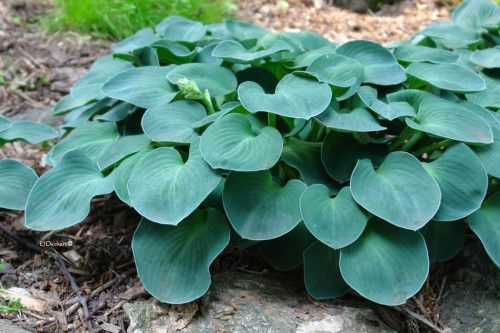
Grade Gold Drop-. Plant height about 20 cm Leaves golden yellow color are oval in shape with a base and sertsevidnym size 6x9 cm flower-bell pale lilac color.. Flowering occurs in July. Best grown on the sunny flowerbed or in partial shade.
Grade Lemon Lime - the height of 15-20 cm rosette leaves golden yellow lanceolate with a wavy edge, size 9h3,5 cm Flower funnel-shaped and bright purple shades... At present petals characteristic strokes. Flowering occurs in late June and lasts until August, provided landing solar flowerbed or penumbra.
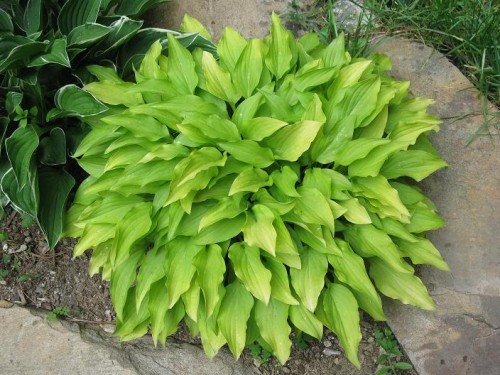
Grade Brim Cup - Average height refers to the group, the outlet height of 25-30 cm Leaves at the center of a dark-green on the edges of creamy white, slightly wrinkled.. Their shape, depending on the growing conditions, varies from round to oval and oblong. Flower-shaped funnel-shaped, color blue-lavender. The sun can burn. Flowering June - July. landing place is recommended to choose the shade or partial shade.
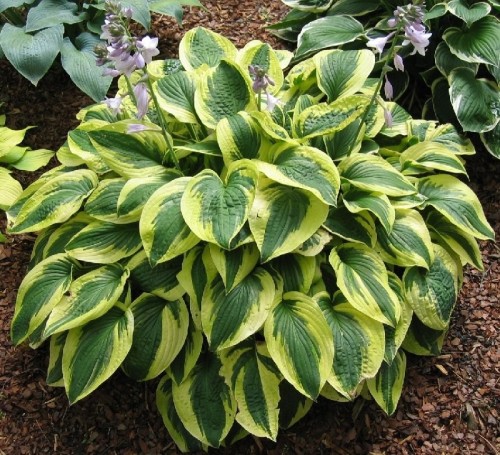
Variety Golden Tiara- forms srednerosloe plant height of 20-25 cm broad, Steel plate with a heart-shaped base.. Color green sheet, there is uneven creamy yellow edging. Flowering lavender-purple bells in July. It grows well in the sun and in the shade.

Grade Christmas Tree - forms the outlet height of 50-55 cm or leaves are broad, rounded and "waffle" texture, dark green with cream-yellow perevidnym bordering.. Flower funnel-shaped white with light lavender shade. Flowers in July.

Grade Gold Standard - refers to the group krupnorosloy, plant height 50-55 cm Leaves are egg-shaped with a small corrugation.. Color lamina yellow-green to dark-green bordering. Blossoms host (next photo) of a light purple funnel-shaped flowers in July. It grows in sun or partial shade.
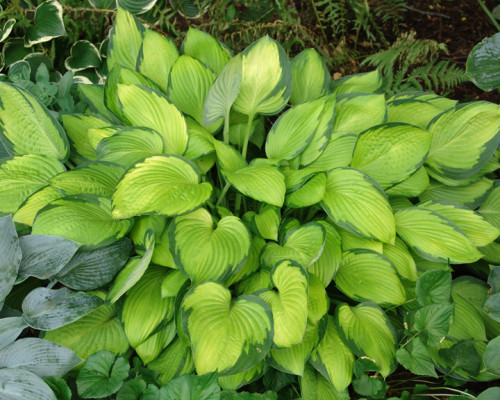
grade Guacamole - a plant reaches a height of 60-65 cm, floral arrow - 100-110 cm Leaves large 28h21 cm, oval, heart-shaped at the bottom, with a well defined veining in the middle of the yellow-green, green on the edge.. Flower funnel-shaped, has a pale lavender color. It flowers in August.
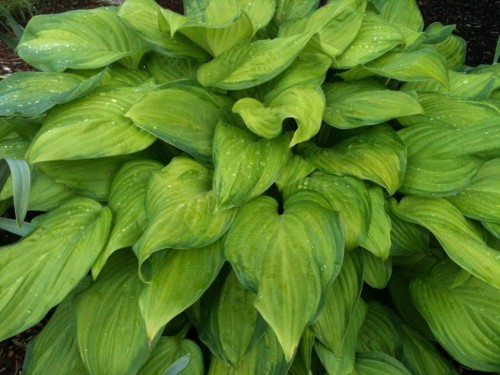
Growing Conditions hosts
The natural habitat hosts grow in thickets, on rocks near water, along the shoreline of forest rivers, wet meadows, and sometimes even on sand dunes. Culture perfectly withstands temperatures + 25-30 ° C, but at +35 ° C in plants begins a period of rest. At this time, the plant does not bloom and often otsushivaet leaves.
Hosts - a hardy plant. Their underground organs are rarely damaged even with strong soil freezing. The plant is cultivated perfectly in all climatic zones, except tropics and the far north.
Hosts require nutritious, evenly moistened, and the soil is structured correctly chosen lighting.
Place host landing
Landing site hosts are selected depending on the intensity of the color of its foliage:
- plants with blue foliage need partial shade or areas shaded in the afternoon. In the shadow of the socket becomes a dark blue-gray, and the sun - gray-green;
- varieties with yellow, white or gold inlays on the leaves require brighter lighting. They are planted in areas where there is sunny in the morning or in the evening. On the sunny flowerbed sheet plate such cultivars prone to burnout;
- sunny lighting is the most resistant variety with green leaves. They are taken to grow in the open plot.
Soil for host
The most acceptable variant of the soil for the host - loam or loose garden land. Sand and clay soil fit. Improve the structure and nutritionality of the soil due to fertilizers. When landing the host into open ground on the surface of the Earth, any organic fertilizer scatter or make it already directly into the landing well. Also, the level of acidity is important for the plant, which should be within 6.5-7.5 pH.
Landing hosts to ground
Plant landing and transplantation are produced throughout the growing season. However, the most successful time for landing the host is spring. Work is carried out according to such a scheme:
- Drop the planting well corresponding to the root seedlock system. The Earth is in the place where the landing is carried out, it should be fertilized from autumn and reappear to the depth of the bayonet shovel.
- On 1/3, cut the roots at the landing plant.
- Place the host Delleka in the PM Center at 2-3 cm below the ground level and crumple the roots.
- Pull with a completely soil and confuse a little.
- Understand the root and dry ground to climb the soil surface near the plant.
When landing on the bed of the host group, the distance between them is 20-100 cm, depending on the varietal dimensions.
When landing the host in the summer, a seedling is mandatory half off the leaves. Large leaf cutters are completely removed.
In the next 5-6 years, no extreme need for bushes is better not to disturb.
Care for the host
Watering
Throughout the eversion of the hosting of the host requires good moisture. The lack of water in the soil leads to fading and drying the plant. Therefore, hosts are recommended infrequently, but to abundantly water. Each adult bush will be required from 10 to 30 liters of water. Watering is carried out in such a way that the water does not fall into the leaves of the plant. The moisture stagnant in the outlet in the hot time leads to the reinforcement of the root cervix.
Podchar
Hosts are responsive to mineral and organic fertilizers. Feed the hosts in the spring in April-May and in August. Comprehensive mineral fertilizers are suitable for decorative garden plants, which in the composition contain nitrogen, phosphorus and potassium. At the end of the summer, the host contributes any potash-phosphoric fertilizer. An excess of nitrogen, both in spring and in the summer for culture, is unacceptable. The excessive amount leads to the loss of the leaves of the motley color.
Additional care
In the middle of the autumn it is recommended to conduct a sanitary trimming of the leaves to remove the slugs from the center of the socket. Rarely, nevertheless, the host occurs mutations: green leaves or shoots of uncharacteristic color appear on volatile varieties. They immediately need to cut, otherwise over time they will displace the varietal sockets.
Host in landscape design
The plant is used in single and group landings, in mixlers, for the framing of a shadow flower garden. Tall hosts look great as a solitator on a well-kept lawn or among the soil plants. Peppercut varieties are well harmonized against the background of Badan, stamps, Kaluzhnitsy. Mini hosts are suitable for container growing.
With proper landing and good care, the host will become an excellent garden decoration over the years.

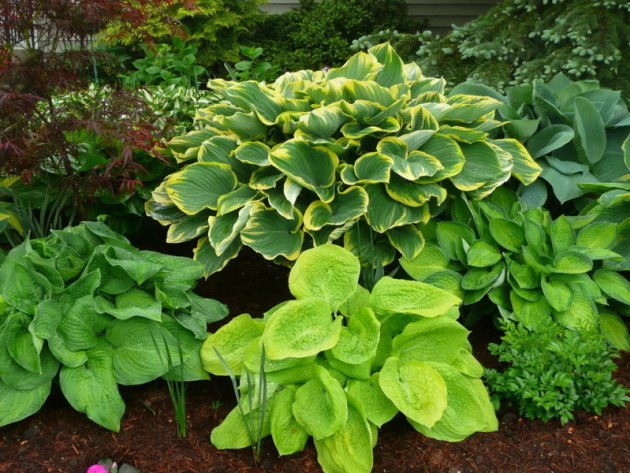
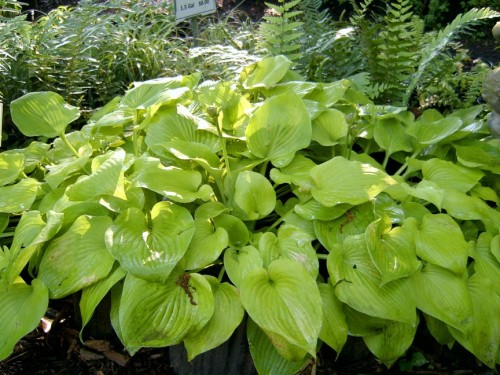
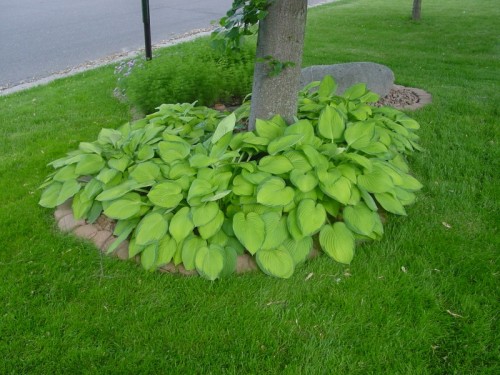













 Start a discussion ...
Start a discussion ...